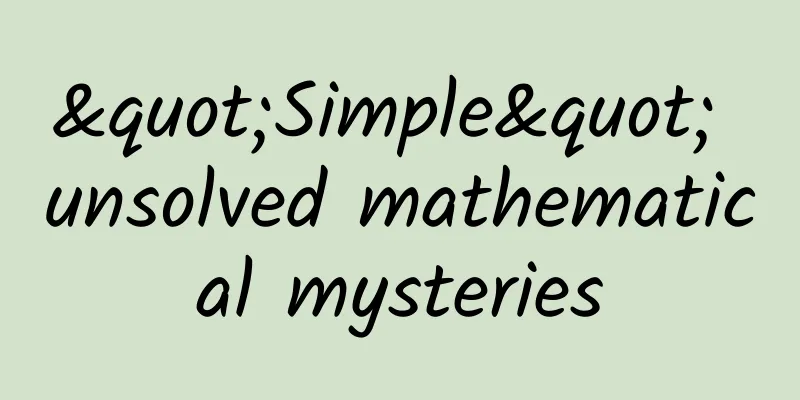"Simple" unsolved mathematical mysteries

|
It's been a long time since we talked about mathematics. Today, let's talk about something lighthearted. This is the unsolved mysteries in mathematics. When you hear this topic, you may first think of the Riemann hypothesis, the Goldbach conjecture, the ABC conjecture, etc. These things are so profound. I'd better turn it off and stop listening to Liu Fusky's bragging. But don't panic. The unsolved mysteries of mathematics we are going to talk about today can be understood by elementary school students. If you haven't graduated from elementary school, forget it and don't make things difficult for yourself. However, although they look simple, their difficulty is no less than that of high-end problems such as the Goldbach conjecture. In the long history of mathematics, generations of mathematicians have come one after another, but they have not yet figured it out. I roughly sorted it out, and today we will take a simple inventory. The first problem is the 3x+1 problem. The statement of this problem is that we start with any positive integer and repeat the operation on it. If it is even, we divide it by 2, and if it is odd, we multiply it by 3 and add 1. So after all this trouble, will we always get the sequence 4,2,1,4,2,1...? What does it mean? Let’s take an example. Take a positive integer, say 28, which is an even number. Divide it by 2 to get 14, which is still an even number. Divide it by 2 again to get 7, which is an odd number. So use 3×7+1, and the result is 22. If we continue the operation, we will get the following sequence: 11,34,17,52,26,13,40,20,10,5,16,8,4,2,1,4,2,1…and then the cycle begins. You can find any positive integer and I believe you will get the same result. Is it the same for all positive integers? This problem seems simple, but it has attracted many mathematicians. We can see the clues from the evolution of the name of this problem. For example, this problem has a lot of names: Colaz conjecture, Syracuse problem, Kakutani conjecture, Hasse algorithm, Ulam problem, etc. Later, it was too confusing, so it was simply called 3x+1 problem. In short, there is no answer to this problem so far. If you really find an exception, you will definitely be famous in the history of mathematics. The second question is question 196. This is a question about palindromes. Palindromes are very simple. Books that read the same forwards or backwards are palindromes, such as 181, 343, etc. Now if you randomly pick a positive integer and keep adding numbers written backwards to it, will you definitely get a palindrome in the end? Let's try it, for example, 69. 69+96=165; 165+561=726; 726+627=1353; 1353+3531=4884. OK, with only four steps of calculation, we get a palindrome. Try it yourself, some numbers may require many steps of calculation, but you will get a palindrome in the end. Intuitively, if we keep adding a number positively and negatively, we will definitely get a palindrome. The computer is calculating and finds nothing wrong. But there is an exception, and what is puzzling is that this exception is not a large number of tens of thousands or hundreds of thousands of digits, but 169. Now mathematicians have used computers to calculate hundreds of millions of steps, but still have not produced a palindrome. So can 169 produce a palindrome? If not, how to prove it? If it can, how many steps does it take? Why is it so special? This question has no answer so far. The third problem is the Gilbreth conjecture. The originator of the idea was a mathematician named Gilbreth. One day, while waiting for his meal in a restaurant, he picked up a napkin and wrote down the sequence of prime numbers on it: 2,3,5,7,11,13,17,19,23,29,31... Then he found the difference between the two adjacent terms, and the result was: 1,2,2,4,2,4,2,4,6,2... Continue this operation and get a new sequence: 1,0,2,2,2,2,2,2,4... Repeat this process: 1,2,0,0,0,0,0,2... As long as you have time, you can make it up at will. In the end, we will find such a pattern, that is, the first number of each row of the sequence is 1. After this discovery, Gilbreth felt very interesting, so he asked his two students to check it. Sure enough, when the brothers calculated to the 64419th row, the beginning of the sequence was still 1, but how to prove it, the three masters and apprentices had no idea. So in 1958, Gilbreth proposed his discovery at a mathematics exchange meeting, and the Gilbreth conjecture was born. Of course, there must be people who don't believe it, so in 1993, a buddy named Andrew Odretzko calculated to the 346 billionth row in one breath, and there was still no exception. So is this an iron law? It has not been proven yet. The fourth problem is called the Hinmaster conjecture. The tool we will use this time is the Pascal's triangle, which we are very familiar with. In Pascal's triangle, the number that appears the most is naturally 1, which has an infinite number of occurrences. So, besides 1, which number appears the most? If we count, we will find that 6 appears 3 times, but this is not too many, and 10 appears 4 times, which is also okay. So which number appears the most? The current answer is 3003, which appears a total of 8 times in Pascal's triangle. Is there a number that appears more times? This is still a mystery. Pascal's Triangle In 1971, mathematician David Hinmaster proposed through some unknown method that there is an upper limit to the number of times a positive integer appears in Pascal's triangle. The upper limit is unknown, but it could be 8, 10, or 12. So does this upper limit exist? What is this upper limit? The mathematical community has not yet answered the question. Well, that's it for today. |
<<: Is it possible for artificial intelligence to replace doctors?
>>: Drinking an average of 1 bottle of beer a day can age your brain by two years
Recommend
This stone forest is a bit strange: Three Ordovician stone forests in my country
In the Karst Grand View Garden, Stone Forest is a...
24-hour emergency response: Beijing's flu cases increased by 16.69% year-on-year
Hot News TOP NEWS Beijing CDC: Influenza cases in...
iOS source code download: Implementing custom drawing functions
Supported platforms: iOS Operating environment: i...
[A Fun Anatomist] Can’t wink? You can always blink!
Speaking of winks, does everyone subconsciously t...
49% of Europe's ultra-fast charging will support 800 volts by 2024, with Germany ranking first with 13,000 seats
BMW will launch an 800-volt electric vehicle later...
Experts: The government should give cash to low-income groups! Who are they specifically included? How much money will each person get?
In March and April of this year, the impact of my...
The Omicron BA.5 variant has been reported in many places! How to prevent it? Please keep in mind
Since July 5, the BA.5 variant of Omicron and its...
Image of lipstick: What is keyword density? Is SEO optimization affected by its density?
Many friends who don’t understand SEO don’t know ...
iOS 9 Learning Series: How UIStackView Makes Your Development Easier
Previously we covered the new features of Swift 2...
Buy, buy, buy! Excessive hoarding of things may be caused by "dementia"? Netizen: My hands are shaking after reading this
Expert of this article: Liang Shan, PhD, Institut...
3 ways to improve user retention through APP operation!
With the disappearance of the Internet's demo...
Have you paid attention to these "bullshit" things?
Whether at home, in the elevator, on the subway, ...
Born for massive film and television resources: TCL iQIYI TV+L48A71C review
Competition in the smart TV industry is becoming i...
How to set up a bidding promotion landing page? How to formulate a bidding promotion landing page?
How to create an effective landing page Ask someo...
With wage arrears and layoffs, is Zhidou going to be in trouble?
According to online reports, more than 80 employe...









